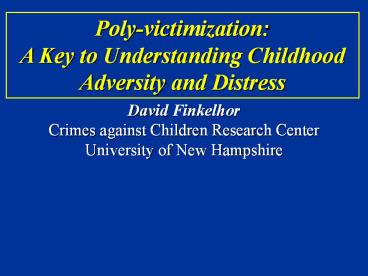Intro - PowerPoint PPT Presentation
1 / 28
Title:
Intro
Description:
Poly-victimization: A Key to Understanding Childhood Adversity and Distress David Finkelhor Crimes against Children Research Center University of New Hampshire – PowerPoint PPT presentation
Number of Views:66
Avg rating:3.0/5.0
Title: Intro
1
Intro
Poly-victimization A Key to Understanding
Childhood Adversity and Distress
David Finkelhor Crimes against Children Research
Center University of New Hampshire
2
Balkans as CV
3
Need for Comprehensive Epidemiology
- Understand full burden on children
- See inter-relationships among victimizations
- Identify highest risk children
- Track trends
- Appreciate developmental patterns
- Compensate for gaps
4
JVQ Logo
5
JVQ Modules
JVQ Modules
- Module A Conventional Crime
- Robbery
- Personal Theft
- Vandalism
- Assault with Weapon
- Assault without Weapon
- Attempted Assault
- Kidnapping
- Bias Attack
- Module D Sexual Victimization
- Sexual Assault by Known Adult
- Nonspecific Sexual Assault
- Sexual Assault by Peer
- Rape Attempted or Completed
- Flashing/Sexual Exposure
- Verbal Sexual Harassment
- Statutory Rape Sexual Misconduct
- Module B Child Maltreatment
- Physical Abuse by Caregiver
- Psychological/Emotional Abuse
- Neglect
- Custodial Interference/Family Abduction
- Module E Witnessing Indirect Victimization
- Witness to Domestic Violence
- Witness to Parent Assault of Sibling
- Witness to Assault with Weapon
- Witness to Assault without Weapon
- Burglary of Family Household
- Murder of Family Member or Friend
- Witness to Murder
- Exposure to Random Shootings, Terrorism or Riots
- Exposure to War or Ethnic Conflict
- Module C Peer Sibling Victimization
- Gang or Group Assault
- Peer or Sibling Assault
- Nonsexual Genital Assault
- Peer physical harassment
- Peer emotional harassment
- Dating Violence
6
National Survey of Childrens Exposure to
Violence (NATSCEV)
- Survey conducted January 2008- May 2008
- National RDD sample of 4549 children age 0-17
- Telephone interviews with 2454 caregivers of
children age 0-9 - Telephone interviews with 2095 youth age 10-17
- Respondents promised confidentiality and paid
20 for participation - Oversample of minorities and low income
- Interviews completed with 71 of eligible
respondents contacted (63 with oversample of
minorities and low income)
7
JVQ Modules
NatSCEV JVQ Additions
- Community Crime Exposure
- Family/friend Sexual Assault
- Family/ friend Robbed
- Family/friend Gun Threat
- Internet Victimization
- Internet Harassment
- Internet Sexual Victimizations
- Family Abuse Exposure
- Parents Threaten Other Parent
- Parents Break Objects
- Parents Push Other Parent
- Parents Slap, Choke, Beat Up
- Any Teen or Grown-up Fight in Household
- School Violence Threat
- Threaten School Bomb or Attack
- School Vandalism
8
Victimization in Last YearTotal and Selected
Aggregates
(Children 0-17, N4549)
61
46
25
25
10
6
9
Past Year Victimization Types and Trauma Symptoms
Poly-victims ?
NATSCEV PY weighted ANOVA includes sex, age,
race/ethnicity, family structure and SES.
10
Seriousness of Poly-victims Victimization
Experiences
11
Polyvictims Domains of Victimization
5
4
3
2
Victimization Domains
12
Characteristics of Polyvictims
13
Polyvictims as a Proportion of Victims of
Particular Types of Victimization
14
Polyvictimization (PV) Swamps Effects of
Individual Victimizations on Trauma
Without PV With PV
Without PV With PV
- Assault
- Maltreatment
- Peer/Sibling
Sexual Victzn Witness Fam Viol Expos to Comm
Viol
Standardized Regression coefficient,
controlling for age, gender, race, ethnicity,
SES, family structure.
15
Figure 2 Trauma Symptom Scores across Victim
Groups
16
Summary of Findings
- Poly-victims
- Often come from disadvantaged groups
- Comprise a large portion of all children who
experience individual types of victimization - Are often exposed to victimization from multiple
contexts or sources
17
Summary of Findings, cont
- Poly-victimization is more highly related to
trauma symptoms than experiencing repeated
victimizations of a single type - Lifetime poly-victimization accounts for most of
the effect of individual victimization types
18
Victimization Event or Condition
- Event
- Focus on event characteristic
- Trauma concept/ Rape prototype
- Condition
- Focus on child and context
- Stressors, Protective factors, coping
19
Discussion
- Why the powerful effect of poly-victimization?
- Represents a condition of victimization rather
than a set of events - Threats to safety, stability, nurturance in
multiple life domains (home, school, community) - Damages resources (social support, coping, self
concept) that help buffer the impact of
victimization
20
Pathways to Poly-victimization
- Dangerous neighborhoods
- Dysfunctional/Violent Parents
- Family adversity
- Existing child mental health problems or
disabilities
21
Pathway 1 Dangerous Families
Child Maltreatment
Violent Parents
Sibling Assault
Peer Victimization
Witness DV, sib maltreatment
22
Pathway 2 Family Problems
Poor Supervision
Peer Victimization
Disruption Adversity
Emotional Deprivation
Sexual Victimization
Property Victimization
Misc. Caretakers Contacts
23
Pathway 3 Dangerous Neighborhoods
Property Crime
Dangerous Neighborhoods
Witnessing
Peer Victimization
Sexual Victimization
24
Pathway 4 Temperament, Disability, Trauma
Mental Health Problems
Burden for Caregivers
Child Maltreatment
Temperament Disability
Poor Social Skills
Peer Victimization
Impaired Self Protection
Sexual Victimization
Stigma
25
Poly-Victimization Onset By Age
26
Assessment Issues about Poly-victimization
- Need to assess a broader range of victimizations
- Important to identify the most highly victimized
youth - Early vs. later onset
- Combination with aggression and delinquency
27
Intervention Issues
- Treatment approaches should address multiple
victimizations - Utility of providing training across
victimization intervention specialties - Mixture of symptom alleviation and skill
development - Multiple intervention contexts (schools, police,
family court, child protection)
28
Key New Knowledge
- New estimates not previously available
- Estimates over full span of childhood
- How many kids suffer from some exposure
- How many kids suffer from multiple exposures
- Increased risk created by any exposure
- Mostly declining trends































